IMC Report: Analysis and Creative Brief for Red Cross Australia
VerifiedAdded on 2023/01/12
|12
|2799
|45
Report
AI Summary
This report provides a comprehensive analysis of the Australian Red Cross Blood Service's Integrated Marketing Communication (IMC) campaign. It begins with an overview of the organization, its competitive environment, current strategies, and target audience, specifically focusing on millennials. The report identifies key problems, such as attracting and retaining stakeholders and creating an exciting brand image. A detailed creative brief is then presented, outlining objectives, brand positioning, demographics, psychographics, and behavioral insights of the target audience. The brief proposes media options, budget allocation, and the AIDA model to create awareness, generate interest, foster desire, and drive action. The report concludes with recommendations for improving the organization's communication strategies and emphasizes the importance of effective advertising and promotional methods. The report also includes a SWOT analysis that highlights the strengths, weaknesses, opportunities, and threats facing the Australian Red Cross Blood Service in the Australian market. This report is based on the course guidelines for an IMC campaign and offers a detailed study of the organization's operations and future strategy.
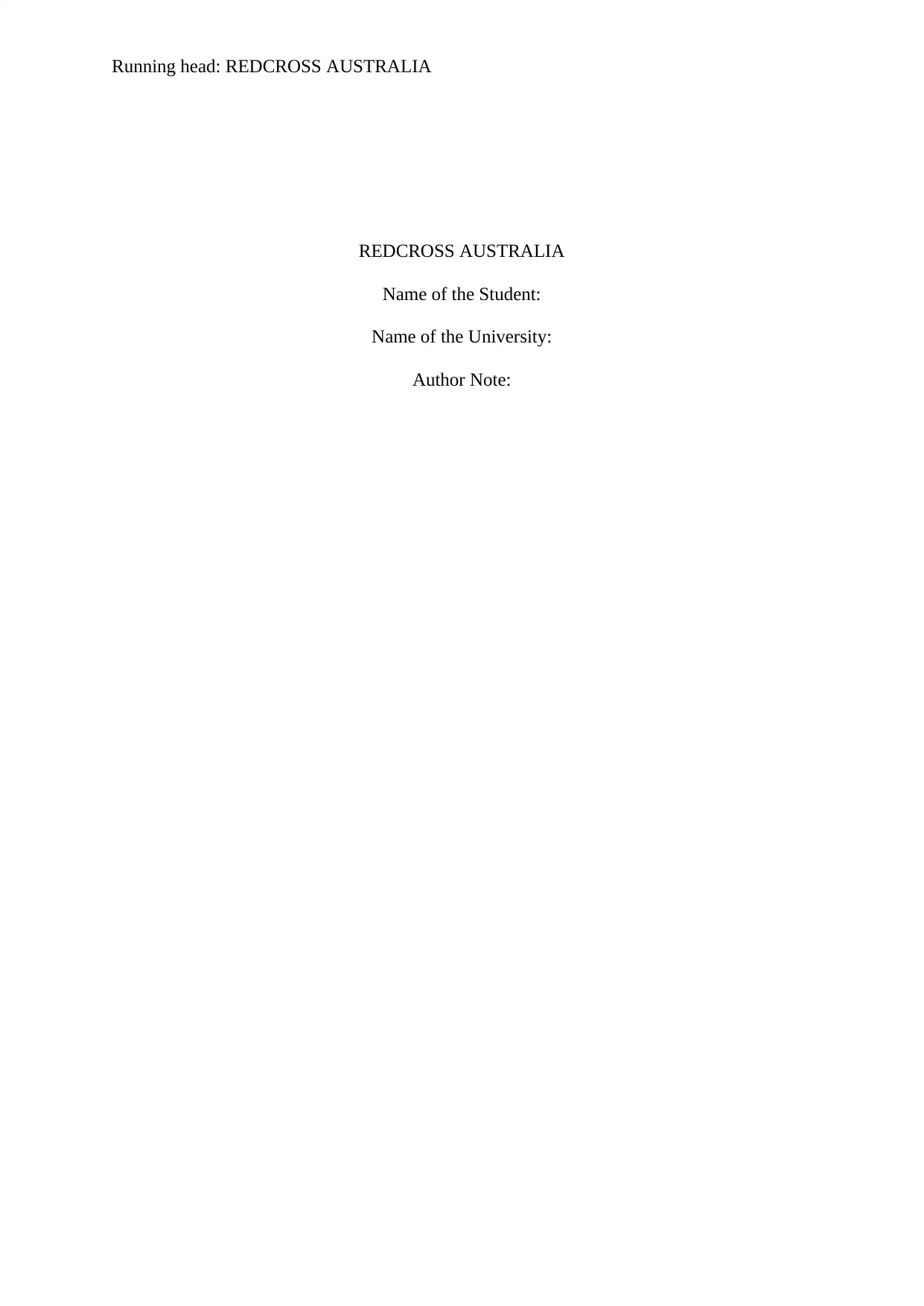
Running head: REDCROSS AUSTRALIA
REDCROSS AUSTRALIA
Name of the Student:
Name of the University:
Author Note:
REDCROSS AUSTRALIA
Name of the Student:
Name of the University:
Author Note:
Paraphrase This Document
Need a fresh take? Get an instant paraphrase of this document with our AI Paraphraser
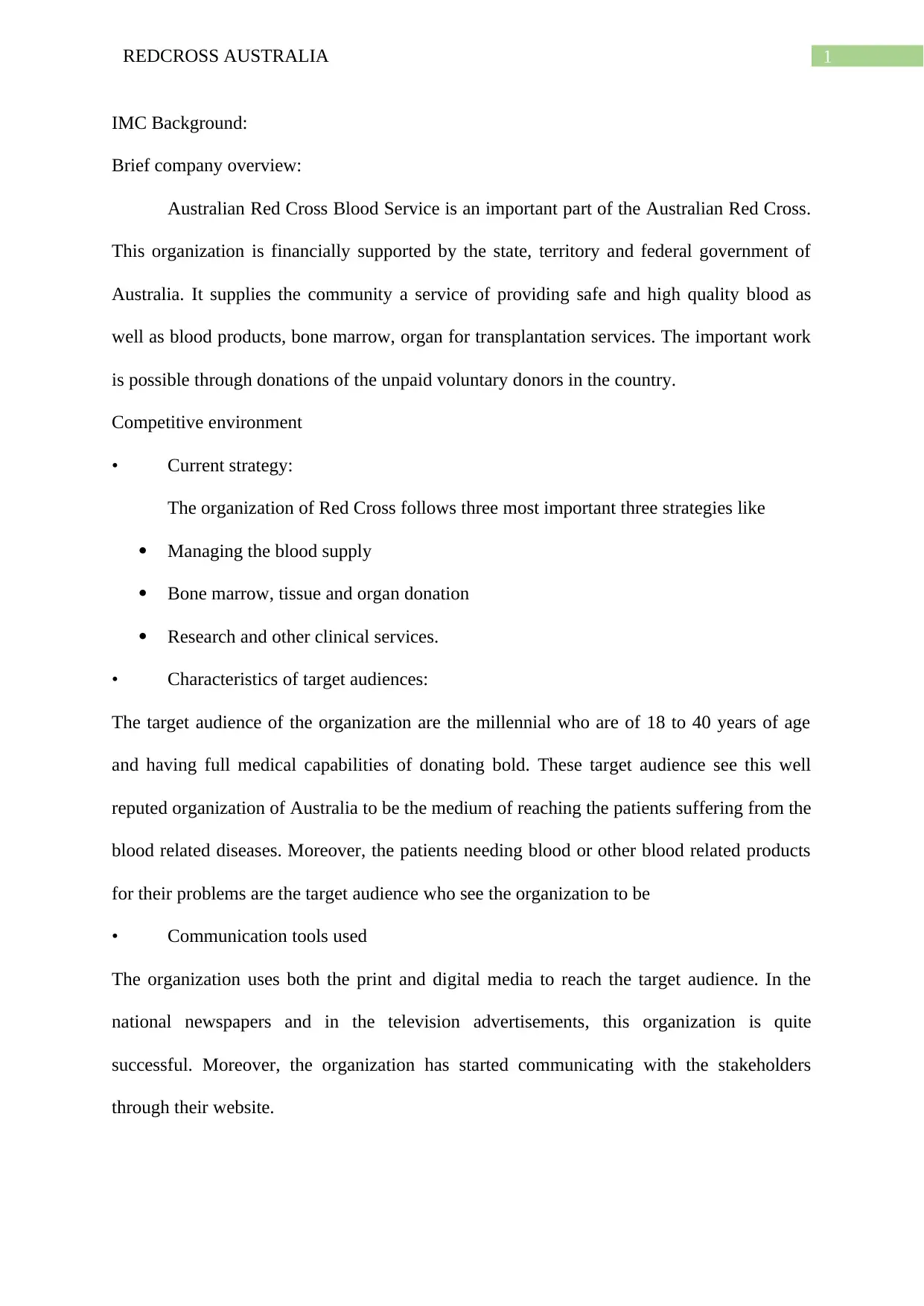
1REDCROSS AUSTRALIA
IMC Background:
Brief company overview:
Australian Red Cross Blood Service is an important part of the Australian Red Cross.
This organization is financially supported by the state, territory and federal government of
Australia. It supplies the community a service of providing safe and high quality blood as
well as blood products, bone marrow, organ for transplantation services. The important work
is possible through donations of the unpaid voluntary donors in the country.
Competitive environment
• Current strategy:
The organization of Red Cross follows three most important three strategies like
Managing the blood supply
Bone marrow, tissue and organ donation
Research and other clinical services.
• Characteristics of target audiences:
The target audience of the organization are the millennial who are of 18 to 40 years of age
and having full medical capabilities of donating bold. These target audience see this well
reputed organization of Australia to be the medium of reaching the patients suffering from the
blood related diseases. Moreover, the patients needing blood or other blood related products
for their problems are the target audience who see the organization to be
• Communication tools used
The organization uses both the print and digital media to reach the target audience. In the
national newspapers and in the television advertisements, this organization is quite
successful. Moreover, the organization has started communicating with the stakeholders
through their website.
IMC Background:
Brief company overview:
Australian Red Cross Blood Service is an important part of the Australian Red Cross.
This organization is financially supported by the state, territory and federal government of
Australia. It supplies the community a service of providing safe and high quality blood as
well as blood products, bone marrow, organ for transplantation services. The important work
is possible through donations of the unpaid voluntary donors in the country.
Competitive environment
• Current strategy:
The organization of Red Cross follows three most important three strategies like
Managing the blood supply
Bone marrow, tissue and organ donation
Research and other clinical services.
• Characteristics of target audiences:
The target audience of the organization are the millennial who are of 18 to 40 years of age
and having full medical capabilities of donating bold. These target audience see this well
reputed organization of Australia to be the medium of reaching the patients suffering from the
blood related diseases. Moreover, the patients needing blood or other blood related products
for their problems are the target audience who see the organization to be
• Communication tools used
The organization uses both the print and digital media to reach the target audience. In the
national newspapers and in the television advertisements, this organization is quite
successful. Moreover, the organization has started communicating with the stakeholders
through their website.
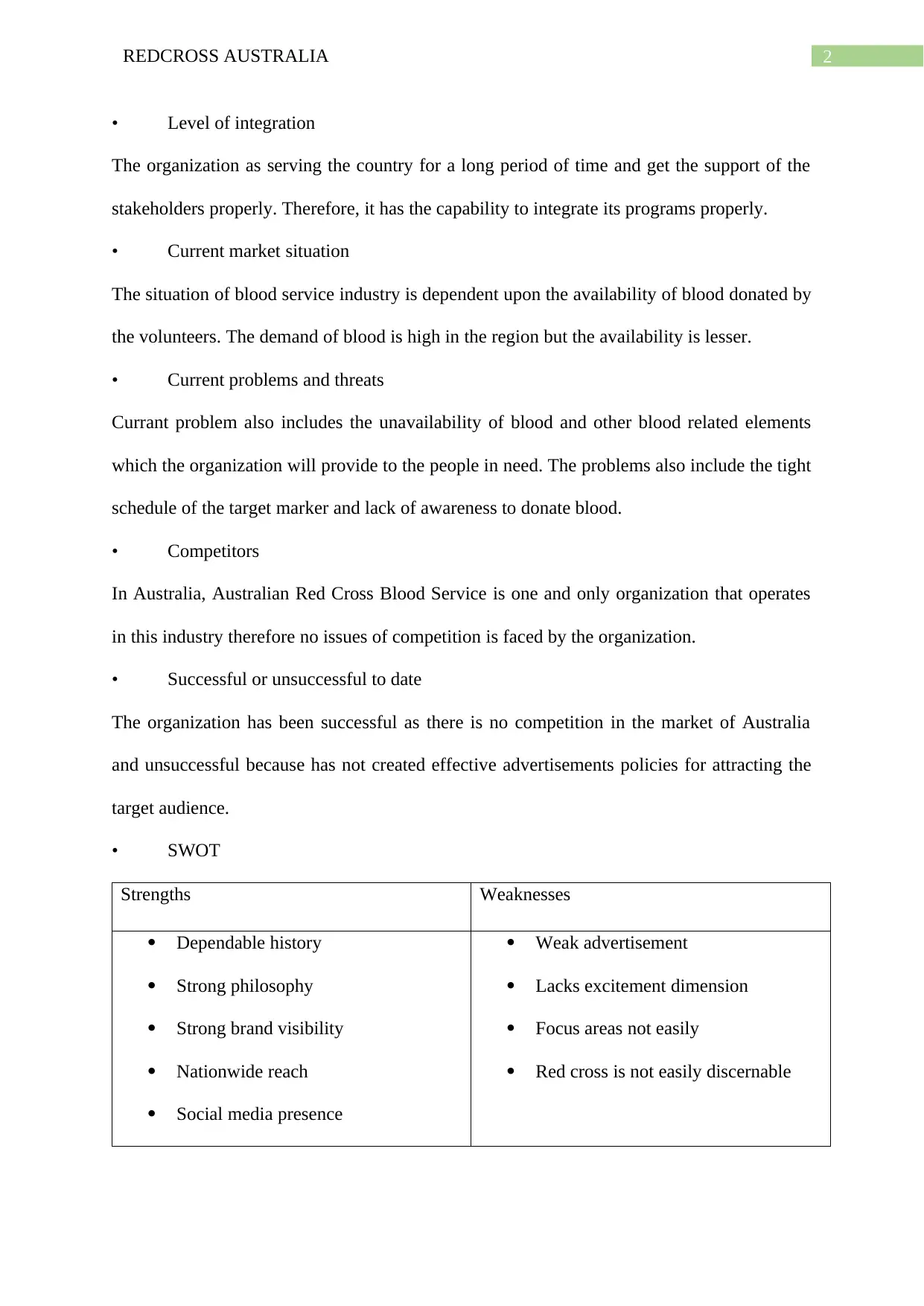
2REDCROSS AUSTRALIA
• Level of integration
The organization as serving the country for a long period of time and get the support of the
stakeholders properly. Therefore, it has the capability to integrate its programs properly.
• Current market situation
The situation of blood service industry is dependent upon the availability of blood donated by
the volunteers. The demand of blood is high in the region but the availability is lesser.
• Current problems and threats
Currant problem also includes the unavailability of blood and other blood related elements
which the organization will provide to the people in need. The problems also include the tight
schedule of the target marker and lack of awareness to donate blood.
• Competitors
In Australia, Australian Red Cross Blood Service is one and only organization that operates
in this industry therefore no issues of competition is faced by the organization.
• Successful or unsuccessful to date
The organization has been successful as there is no competition in the market of Australia
and unsuccessful because has not created effective advertisements policies for attracting the
target audience.
• SWOT
Strengths Weaknesses
Dependable history
Strong philosophy
Strong brand visibility
Nationwide reach
Social media presence
Weak advertisement
Lacks excitement dimension
Focus areas not easily
Red cross is not easily discernable
• Level of integration
The organization as serving the country for a long period of time and get the support of the
stakeholders properly. Therefore, it has the capability to integrate its programs properly.
• Current market situation
The situation of blood service industry is dependent upon the availability of blood donated by
the volunteers. The demand of blood is high in the region but the availability is lesser.
• Current problems and threats
Currant problem also includes the unavailability of blood and other blood related elements
which the organization will provide to the people in need. The problems also include the tight
schedule of the target marker and lack of awareness to donate blood.
• Competitors
In Australia, Australian Red Cross Blood Service is one and only organization that operates
in this industry therefore no issues of competition is faced by the organization.
• Successful or unsuccessful to date
The organization has been successful as there is no competition in the market of Australia
and unsuccessful because has not created effective advertisements policies for attracting the
target audience.
• SWOT
Strengths Weaknesses
Dependable history
Strong philosophy
Strong brand visibility
Nationwide reach
Social media presence
Weak advertisement
Lacks excitement dimension
Focus areas not easily
Red cross is not easily discernable
⊘ This is a preview!⊘
Do you want full access?
Subscribe today to unlock all pages.

Trusted by 1+ million students worldwide
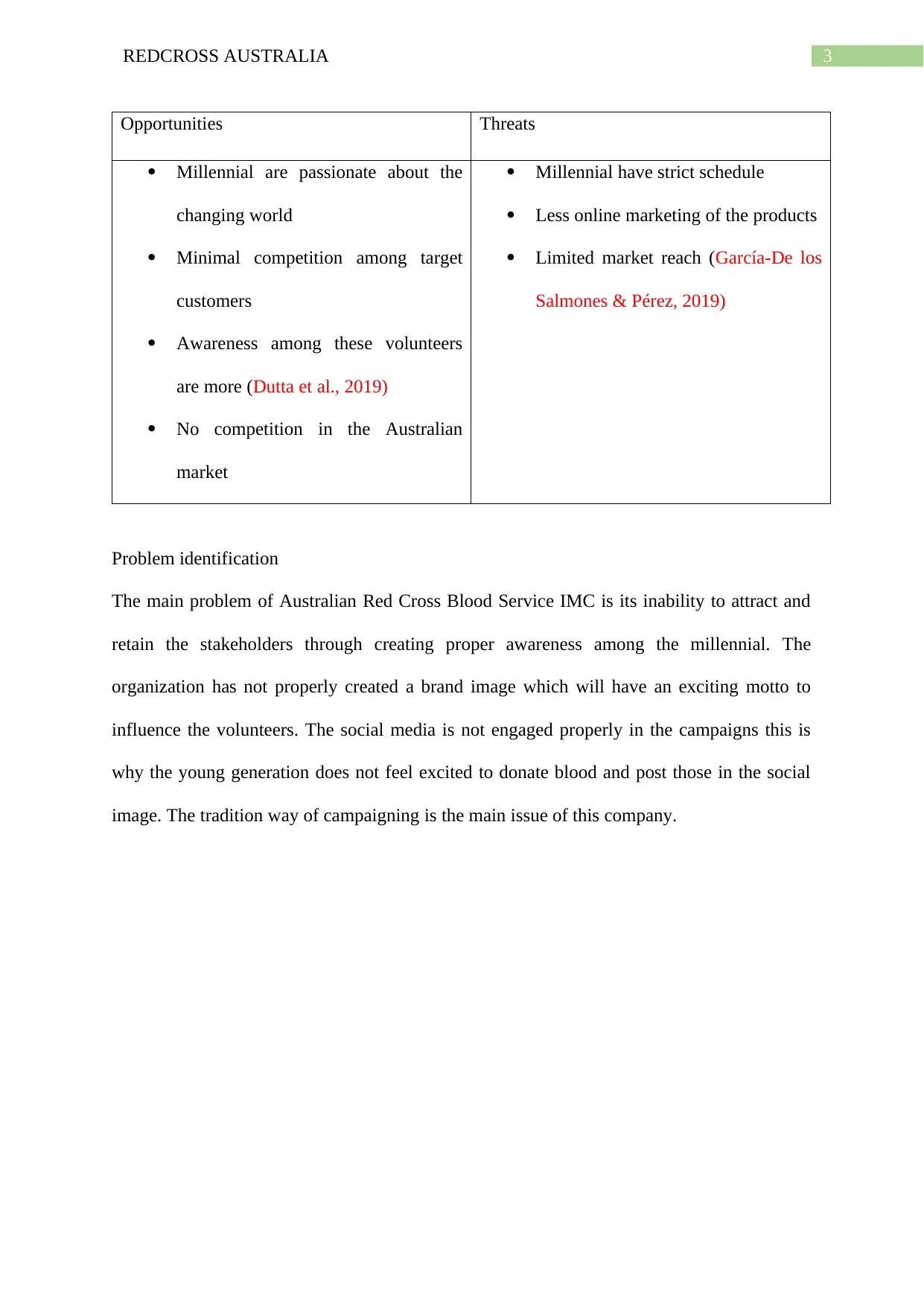
3REDCROSS AUSTRALIA
Opportunities Threats
Millennial are passionate about the
changing world
Minimal competition among target
customers
Awareness among these volunteers
are more (Dutta et al., 2019)
No competition in the Australian
market
Millennial have strict schedule
Less online marketing of the products
Limited market reach (García-De los
Salmones & Pérez, 2019)
Problem identification
The main problem of Australian Red Cross Blood Service IMC is its inability to attract and
retain the stakeholders through creating proper awareness among the millennial. The
organization has not properly created a brand image which will have an exciting motto to
influence the volunteers. The social media is not engaged properly in the campaigns this is
why the young generation does not feel excited to donate blood and post those in the social
image. The tradition way of campaigning is the main issue of this company.
Opportunities Threats
Millennial are passionate about the
changing world
Minimal competition among target
customers
Awareness among these volunteers
are more (Dutta et al., 2019)
No competition in the Australian
market
Millennial have strict schedule
Less online marketing of the products
Limited market reach (García-De los
Salmones & Pérez, 2019)
Problem identification
The main problem of Australian Red Cross Blood Service IMC is its inability to attract and
retain the stakeholders through creating proper awareness among the millennial. The
organization has not properly created a brand image which will have an exciting motto to
influence the volunteers. The social media is not engaged properly in the campaigns this is
why the young generation does not feel excited to donate blood and post those in the social
image. The tradition way of campaigning is the main issue of this company.
Paraphrase This Document
Need a fresh take? Get an instant paraphrase of this document with our AI Paraphraser
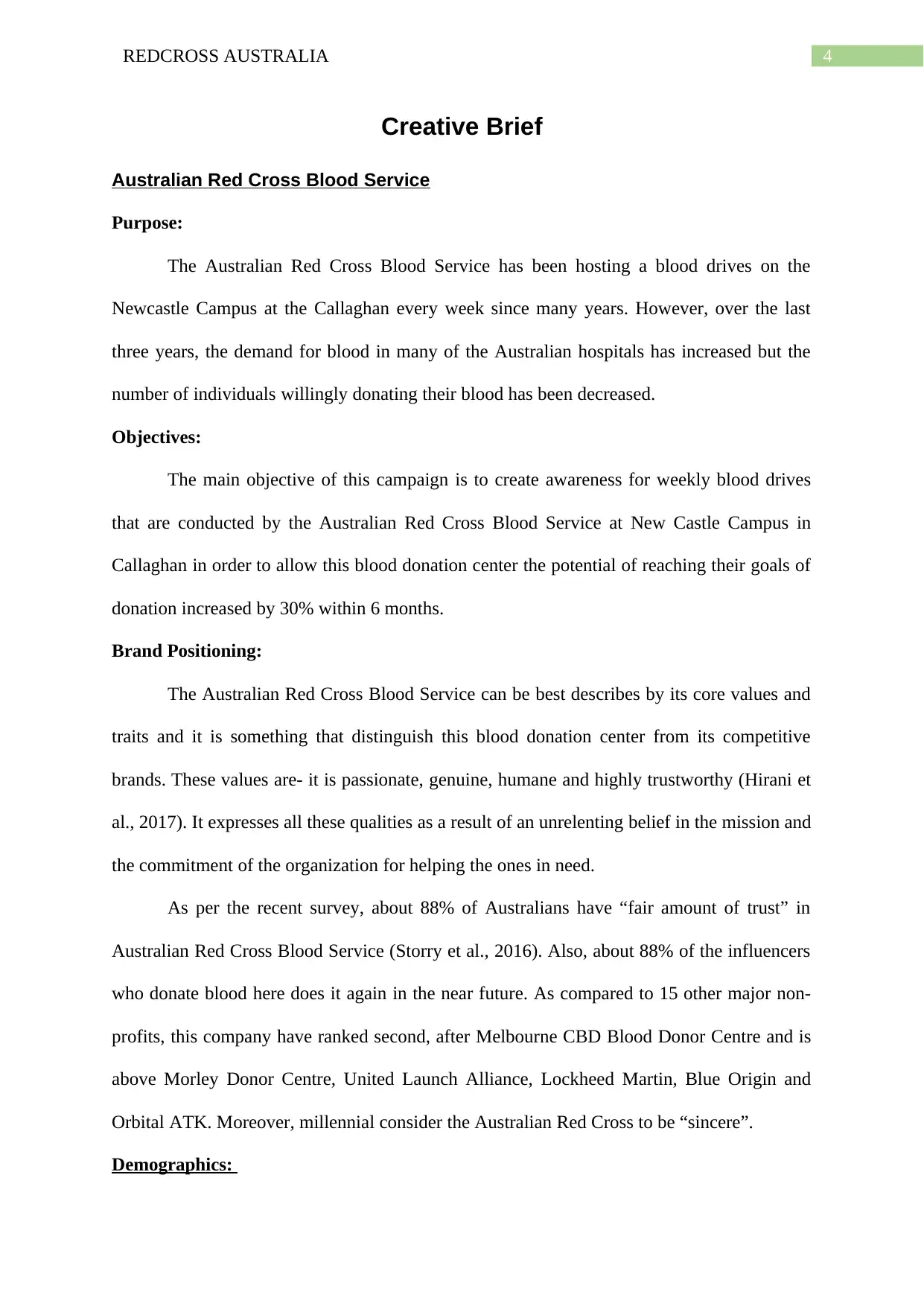
4REDCROSS AUSTRALIA
Creative Brief
Australian Red Cross Blood Service
Purpose:
The Australian Red Cross Blood Service has been hosting a blood drives on the
Newcastle Campus at the Callaghan every week since many years. However, over the last
three years, the demand for blood in many of the Australian hospitals has increased but the
number of individuals willingly donating their blood has been decreased.
Objectives:
The main objective of this campaign is to create awareness for weekly blood drives
that are conducted by the Australian Red Cross Blood Service at New Castle Campus in
Callaghan in order to allow this blood donation center the potential of reaching their goals of
donation increased by 30% within 6 months.
Brand Positioning:
The Australian Red Cross Blood Service can be best describes by its core values and
traits and it is something that distinguish this blood donation center from its competitive
brands. These values are- it is passionate, genuine, humane and highly trustworthy (Hirani et
al., 2017). It expresses all these qualities as a result of an unrelenting belief in the mission and
the commitment of the organization for helping the ones in need.
As per the recent survey, about 88% of Australians have “fair amount of trust” in
Australian Red Cross Blood Service (Storry et al., 2016). Also, about 88% of the influencers
who donate blood here does it again in the near future. As compared to 15 other major non-
profits, this company have ranked second, after Melbourne CBD Blood Donor Centre and is
above Morley Donor Centre, United Launch Alliance, Lockheed Martin, Blue Origin and
Orbital ATK. Moreover, millennial consider the Australian Red Cross to be “sincere”.
Demographics:
Creative Brief
Australian Red Cross Blood Service
Purpose:
The Australian Red Cross Blood Service has been hosting a blood drives on the
Newcastle Campus at the Callaghan every week since many years. However, over the last
three years, the demand for blood in many of the Australian hospitals has increased but the
number of individuals willingly donating their blood has been decreased.
Objectives:
The main objective of this campaign is to create awareness for weekly blood drives
that are conducted by the Australian Red Cross Blood Service at New Castle Campus in
Callaghan in order to allow this blood donation center the potential of reaching their goals of
donation increased by 30% within 6 months.
Brand Positioning:
The Australian Red Cross Blood Service can be best describes by its core values and
traits and it is something that distinguish this blood donation center from its competitive
brands. These values are- it is passionate, genuine, humane and highly trustworthy (Hirani et
al., 2017). It expresses all these qualities as a result of an unrelenting belief in the mission and
the commitment of the organization for helping the ones in need.
As per the recent survey, about 88% of Australians have “fair amount of trust” in
Australian Red Cross Blood Service (Storry et al., 2016). Also, about 88% of the influencers
who donate blood here does it again in the near future. As compared to 15 other major non-
profits, this company have ranked second, after Melbourne CBD Blood Donor Centre and is
above Morley Donor Centre, United Launch Alliance, Lockheed Martin, Blue Origin and
Orbital ATK. Moreover, millennial consider the Australian Red Cross to be “sincere”.
Demographics:
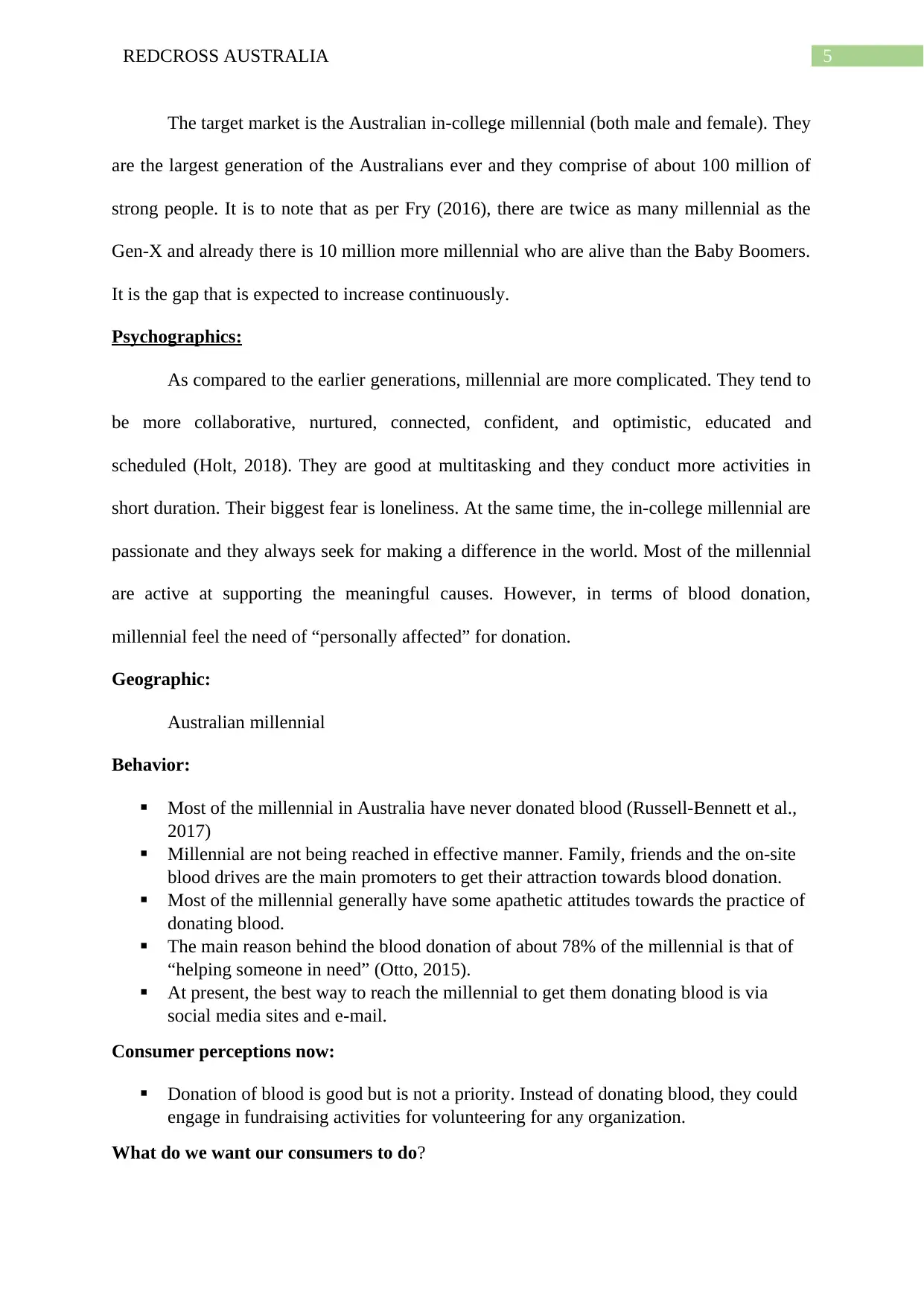
5REDCROSS AUSTRALIA
The target market is the Australian in-college millennial (both male and female). They
are the largest generation of the Australians ever and they comprise of about 100 million of
strong people. It is to note that as per Fry (2016), there are twice as many millennial as the
Gen-X and already there is 10 million more millennial who are alive than the Baby Boomers.
It is the gap that is expected to increase continuously.
Psychographics:
As compared to the earlier generations, millennial are more complicated. They tend to
be more collaborative, nurtured, connected, confident, and optimistic, educated and
scheduled (Holt, 2018). They are good at multitasking and they conduct more activities in
short duration. Their biggest fear is loneliness. At the same time, the in-college millennial are
passionate and they always seek for making a difference in the world. Most of the millennial
are active at supporting the meaningful causes. However, in terms of blood donation,
millennial feel the need of “personally affected” for donation.
Geographic:
Australian millennial
Behavior:
Most of the millennial in Australia have never donated blood (Russell-Bennett et al.,
2017)
Millennial are not being reached in effective manner. Family, friends and the on-site
blood drives are the main promoters to get their attraction towards blood donation.
Most of the millennial generally have some apathetic attitudes towards the practice of
donating blood.
The main reason behind the blood donation of about 78% of the millennial is that of
“helping someone in need” (Otto, 2015).
At present, the best way to reach the millennial to get them donating blood is via
social media sites and e-mail.
Consumer perceptions now:
Donation of blood is good but is not a priority. Instead of donating blood, they could
engage in fundraising activities for volunteering for any organization.
What do we want our consumers to do?
The target market is the Australian in-college millennial (both male and female). They
are the largest generation of the Australians ever and they comprise of about 100 million of
strong people. It is to note that as per Fry (2016), there are twice as many millennial as the
Gen-X and already there is 10 million more millennial who are alive than the Baby Boomers.
It is the gap that is expected to increase continuously.
Psychographics:
As compared to the earlier generations, millennial are more complicated. They tend to
be more collaborative, nurtured, connected, confident, and optimistic, educated and
scheduled (Holt, 2018). They are good at multitasking and they conduct more activities in
short duration. Their biggest fear is loneliness. At the same time, the in-college millennial are
passionate and they always seek for making a difference in the world. Most of the millennial
are active at supporting the meaningful causes. However, in terms of blood donation,
millennial feel the need of “personally affected” for donation.
Geographic:
Australian millennial
Behavior:
Most of the millennial in Australia have never donated blood (Russell-Bennett et al.,
2017)
Millennial are not being reached in effective manner. Family, friends and the on-site
blood drives are the main promoters to get their attraction towards blood donation.
Most of the millennial generally have some apathetic attitudes towards the practice of
donating blood.
The main reason behind the blood donation of about 78% of the millennial is that of
“helping someone in need” (Otto, 2015).
At present, the best way to reach the millennial to get them donating blood is via
social media sites and e-mail.
Consumer perceptions now:
Donation of blood is good but is not a priority. Instead of donating blood, they could
engage in fundraising activities for volunteering for any organization.
What do we want our consumers to do?
⊘ This is a preview!⊘
Do you want full access?
Subscribe today to unlock all pages.

Trusted by 1+ million students worldwide
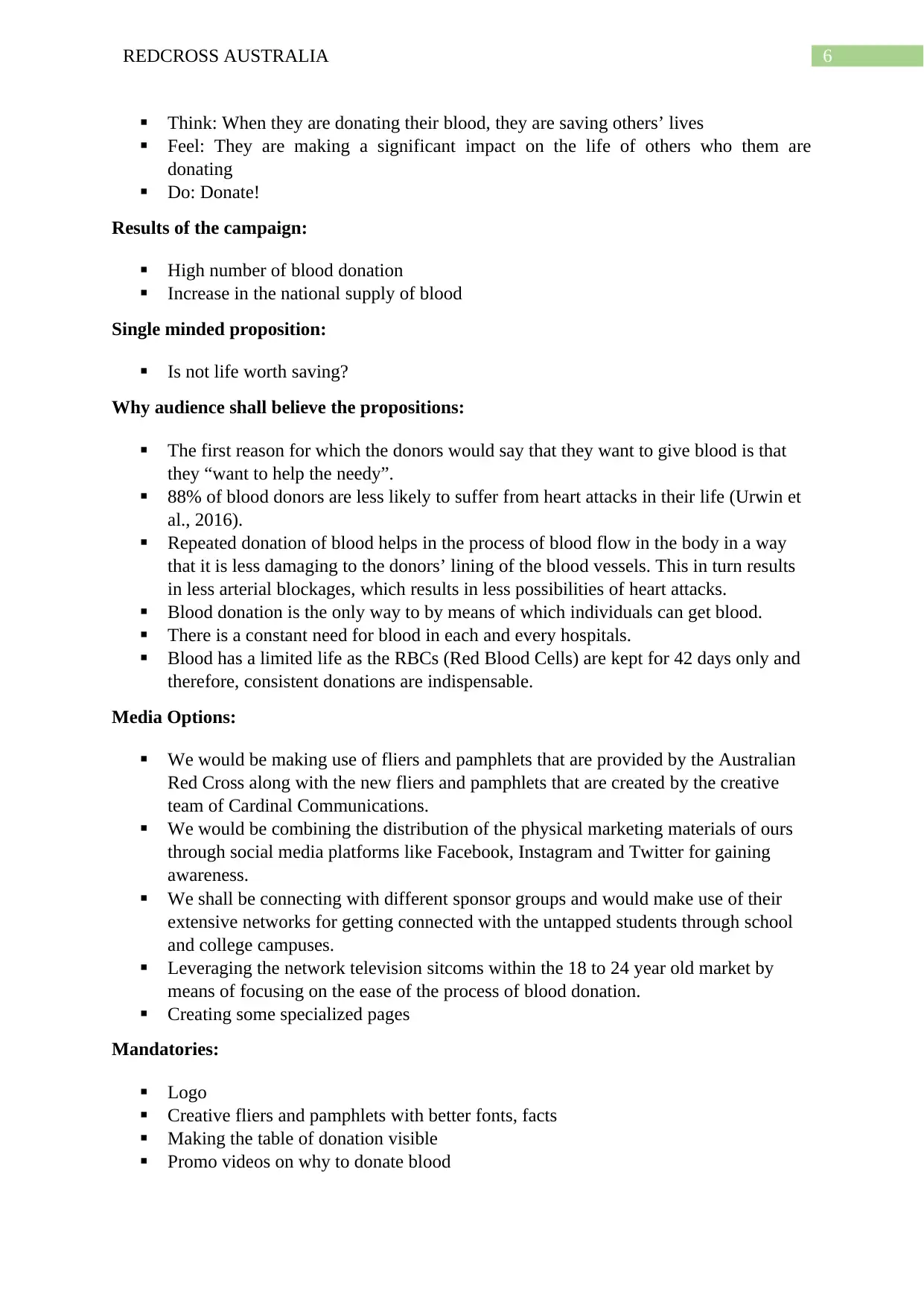
6REDCROSS AUSTRALIA
Think: When they are donating their blood, they are saving others’ lives
Feel: They are making a significant impact on the life of others who them are
donating
Do: Donate!
Results of the campaign:
High number of blood donation
Increase in the national supply of blood
Single minded proposition:
Is not life worth saving?
Why audience shall believe the propositions:
The first reason for which the donors would say that they want to give blood is that
they “want to help the needy”.
88% of blood donors are less likely to suffer from heart attacks in their life (Urwin et
al., 2016).
Repeated donation of blood helps in the process of blood flow in the body in a way
that it is less damaging to the donors’ lining of the blood vessels. This in turn results
in less arterial blockages, which results in less possibilities of heart attacks.
Blood donation is the only way to by means of which individuals can get blood.
There is a constant need for blood in each and every hospitals.
Blood has a limited life as the RBCs (Red Blood Cells) are kept for 42 days only and
therefore, consistent donations are indispensable.
Media Options:
We would be making use of fliers and pamphlets that are provided by the Australian
Red Cross along with the new fliers and pamphlets that are created by the creative
team of Cardinal Communications.
We would be combining the distribution of the physical marketing materials of ours
through social media platforms like Facebook, Instagram and Twitter for gaining
awareness.
We shall be connecting with different sponsor groups and would make use of their
extensive networks for getting connected with the untapped students through school
and college campuses.
Leveraging the network television sitcoms within the 18 to 24 year old market by
means of focusing on the ease of the process of blood donation.
Creating some specialized pages
Mandatories:
Logo
Creative fliers and pamphlets with better fonts, facts
Making the table of donation visible
Promo videos on why to donate blood
Think: When they are donating their blood, they are saving others’ lives
Feel: They are making a significant impact on the life of others who them are
donating
Do: Donate!
Results of the campaign:
High number of blood donation
Increase in the national supply of blood
Single minded proposition:
Is not life worth saving?
Why audience shall believe the propositions:
The first reason for which the donors would say that they want to give blood is that
they “want to help the needy”.
88% of blood donors are less likely to suffer from heart attacks in their life (Urwin et
al., 2016).
Repeated donation of blood helps in the process of blood flow in the body in a way
that it is less damaging to the donors’ lining of the blood vessels. This in turn results
in less arterial blockages, which results in less possibilities of heart attacks.
Blood donation is the only way to by means of which individuals can get blood.
There is a constant need for blood in each and every hospitals.
Blood has a limited life as the RBCs (Red Blood Cells) are kept for 42 days only and
therefore, consistent donations are indispensable.
Media Options:
We would be making use of fliers and pamphlets that are provided by the Australian
Red Cross along with the new fliers and pamphlets that are created by the creative
team of Cardinal Communications.
We would be combining the distribution of the physical marketing materials of ours
through social media platforms like Facebook, Instagram and Twitter for gaining
awareness.
We shall be connecting with different sponsor groups and would make use of their
extensive networks for getting connected with the untapped students through school
and college campuses.
Leveraging the network television sitcoms within the 18 to 24 year old market by
means of focusing on the ease of the process of blood donation.
Creating some specialized pages
Mandatories:
Logo
Creative fliers and pamphlets with better fonts, facts
Making the table of donation visible
Promo videos on why to donate blood
Paraphrase This Document
Need a fresh take? Get an instant paraphrase of this document with our AI Paraphraser
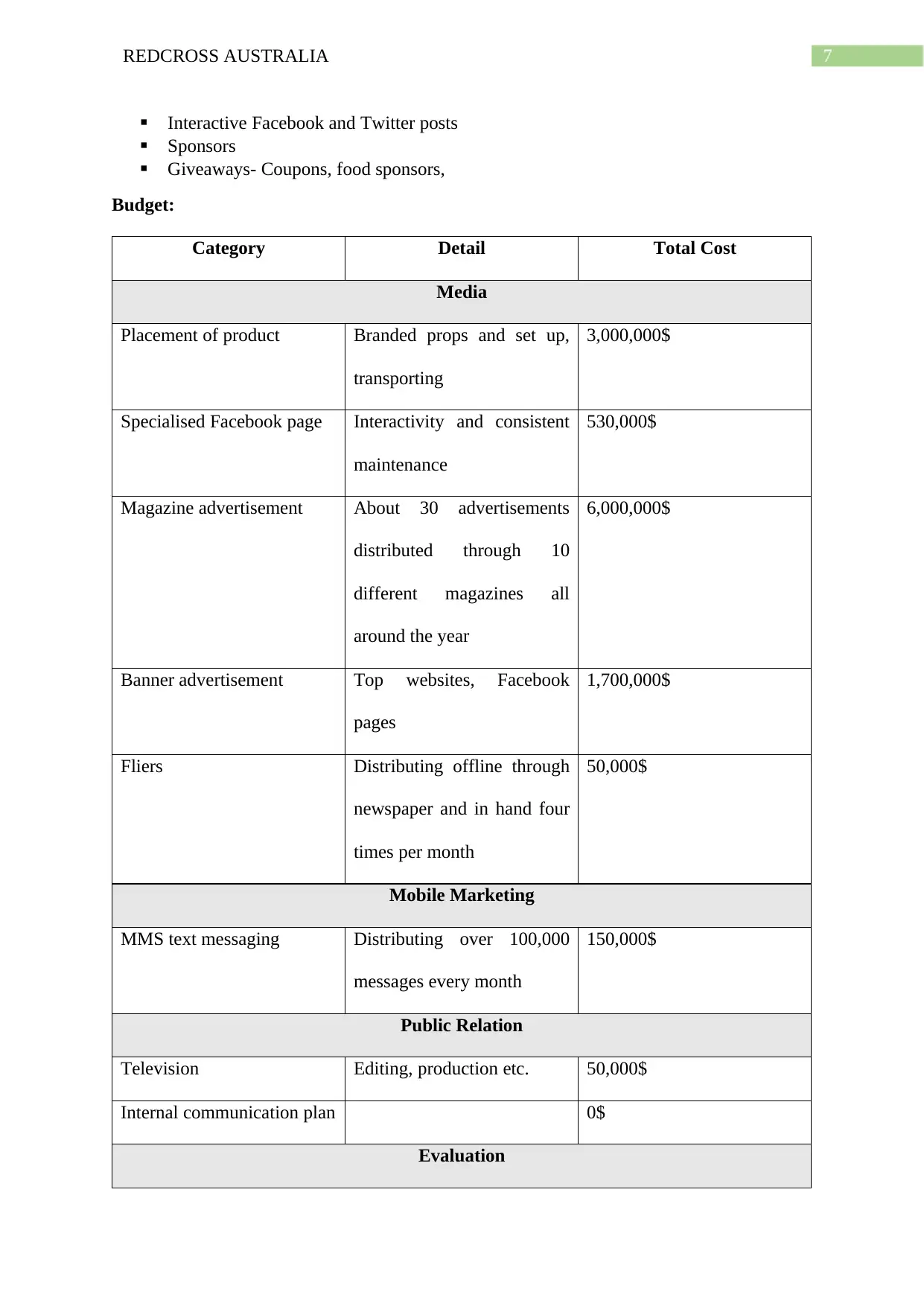
7REDCROSS AUSTRALIA
Interactive Facebook and Twitter posts
Sponsors
Giveaways- Coupons, food sponsors,
Budget:
Category Detail Total Cost
Media
Placement of product Branded props and set up,
transporting
3,000,000$
Specialised Facebook page Interactivity and consistent
maintenance
530,000$
Magazine advertisement About 30 advertisements
distributed through 10
different magazines all
around the year
6,000,000$
Banner advertisement Top websites, Facebook
pages
1,700,000$
Fliers Distributing offline through
newspaper and in hand four
times per month
50,000$
Mobile Marketing
MMS text messaging Distributing over 100,000
messages every month
150,000$
Public Relation
Television Editing, production etc. 50,000$
Internal communication plan 0$
Evaluation
Interactive Facebook and Twitter posts
Sponsors
Giveaways- Coupons, food sponsors,
Budget:
Category Detail Total Cost
Media
Placement of product Branded props and set up,
transporting
3,000,000$
Specialised Facebook page Interactivity and consistent
maintenance
530,000$
Magazine advertisement About 30 advertisements
distributed through 10
different magazines all
around the year
6,000,000$
Banner advertisement Top websites, Facebook
pages
1,700,000$
Fliers Distributing offline through
newspaper and in hand four
times per month
50,000$
Mobile Marketing
MMS text messaging Distributing over 100,000
messages every month
150,000$
Public Relation
Television Editing, production etc. 50,000$
Internal communication plan 0$
Evaluation
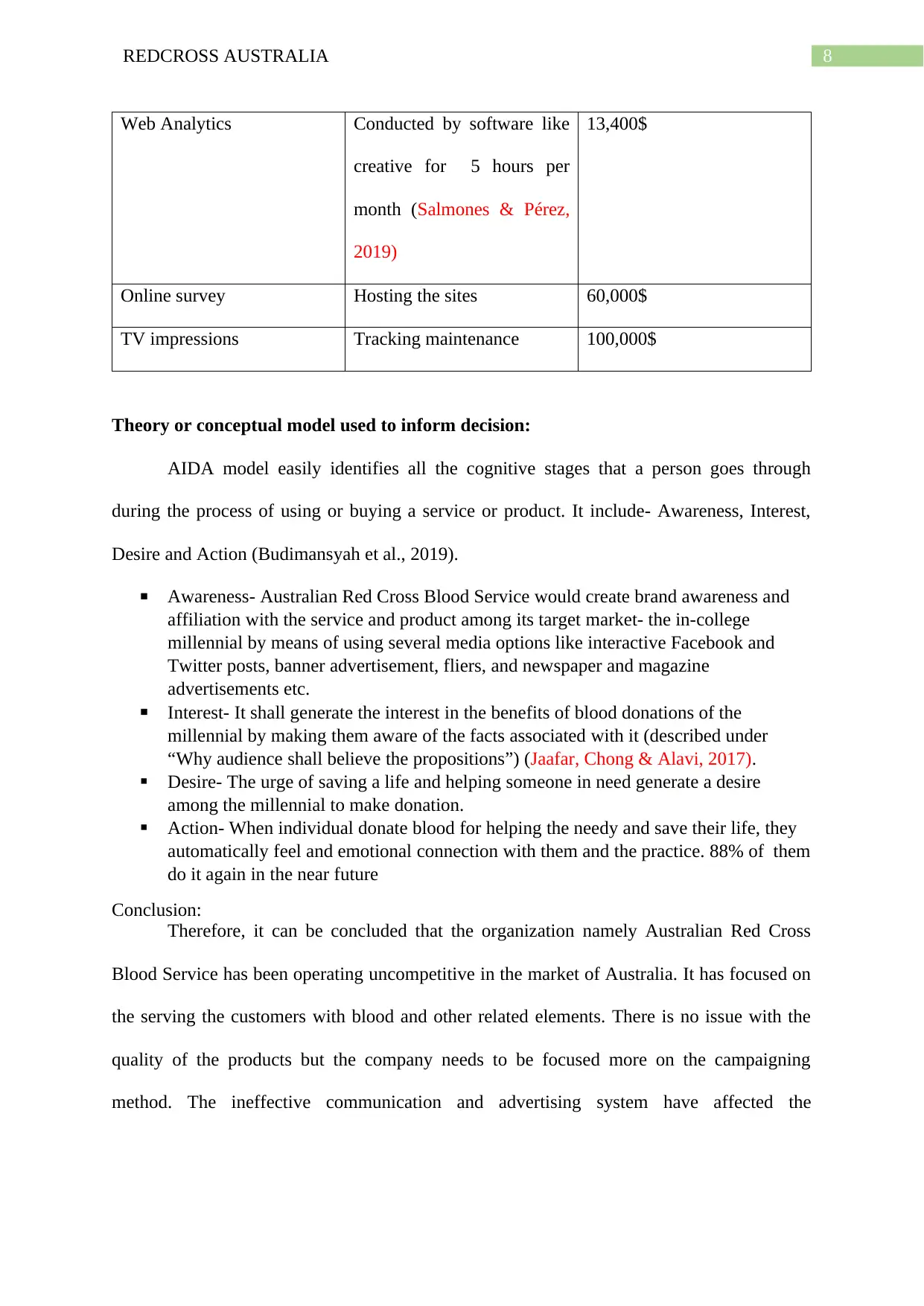
8REDCROSS AUSTRALIA
Web Analytics Conducted by software like
creative for 5 hours per
month (Salmones & Pérez,
2019)
13,400$
Online survey Hosting the sites 60,000$
TV impressions Tracking maintenance 100,000$
Theory or conceptual model used to inform decision:
AIDA model easily identifies all the cognitive stages that a person goes through
during the process of using or buying a service or product. It include- Awareness, Interest,
Desire and Action (Budimansyah et al., 2019).
Awareness- Australian Red Cross Blood Service would create brand awareness and
affiliation with the service and product among its target market- the in-college
millennial by means of using several media options like interactive Facebook and
Twitter posts, banner advertisement, fliers, and newspaper and magazine
advertisements etc.
Interest- It shall generate the interest in the benefits of blood donations of the
millennial by making them aware of the facts associated with it (described under
“Why audience shall believe the propositions”) (Jaafar, Chong & Alavi, 2017).
Desire- The urge of saving a life and helping someone in need generate a desire
among the millennial to make donation.
Action- When individual donate blood for helping the needy and save their life, they
automatically feel and emotional connection with them and the practice. 88% of them
do it again in the near future
Conclusion:
Therefore, it can be concluded that the organization namely Australian Red Cross
Blood Service has been operating uncompetitive in the market of Australia. It has focused on
the serving the customers with blood and other related elements. There is no issue with the
quality of the products but the company needs to be focused more on the campaigning
method. The ineffective communication and advertising system have affected the
Web Analytics Conducted by software like
creative for 5 hours per
month (Salmones & Pérez,
2019)
13,400$
Online survey Hosting the sites 60,000$
TV impressions Tracking maintenance 100,000$
Theory or conceptual model used to inform decision:
AIDA model easily identifies all the cognitive stages that a person goes through
during the process of using or buying a service or product. It include- Awareness, Interest,
Desire and Action (Budimansyah et al., 2019).
Awareness- Australian Red Cross Blood Service would create brand awareness and
affiliation with the service and product among its target market- the in-college
millennial by means of using several media options like interactive Facebook and
Twitter posts, banner advertisement, fliers, and newspaper and magazine
advertisements etc.
Interest- It shall generate the interest in the benefits of blood donations of the
millennial by making them aware of the facts associated with it (described under
“Why audience shall believe the propositions”) (Jaafar, Chong & Alavi, 2017).
Desire- The urge of saving a life and helping someone in need generate a desire
among the millennial to make donation.
Action- When individual donate blood for helping the needy and save their life, they
automatically feel and emotional connection with them and the practice. 88% of them
do it again in the near future
Conclusion:
Therefore, it can be concluded that the organization namely Australian Red Cross
Blood Service has been operating uncompetitive in the market of Australia. It has focused on
the serving the customers with blood and other related elements. There is no issue with the
quality of the products but the company needs to be focused more on the campaigning
method. The ineffective communication and advertising system have affected the
⊘ This is a preview!⊘
Do you want full access?
Subscribe today to unlock all pages.

Trusted by 1+ million students worldwide
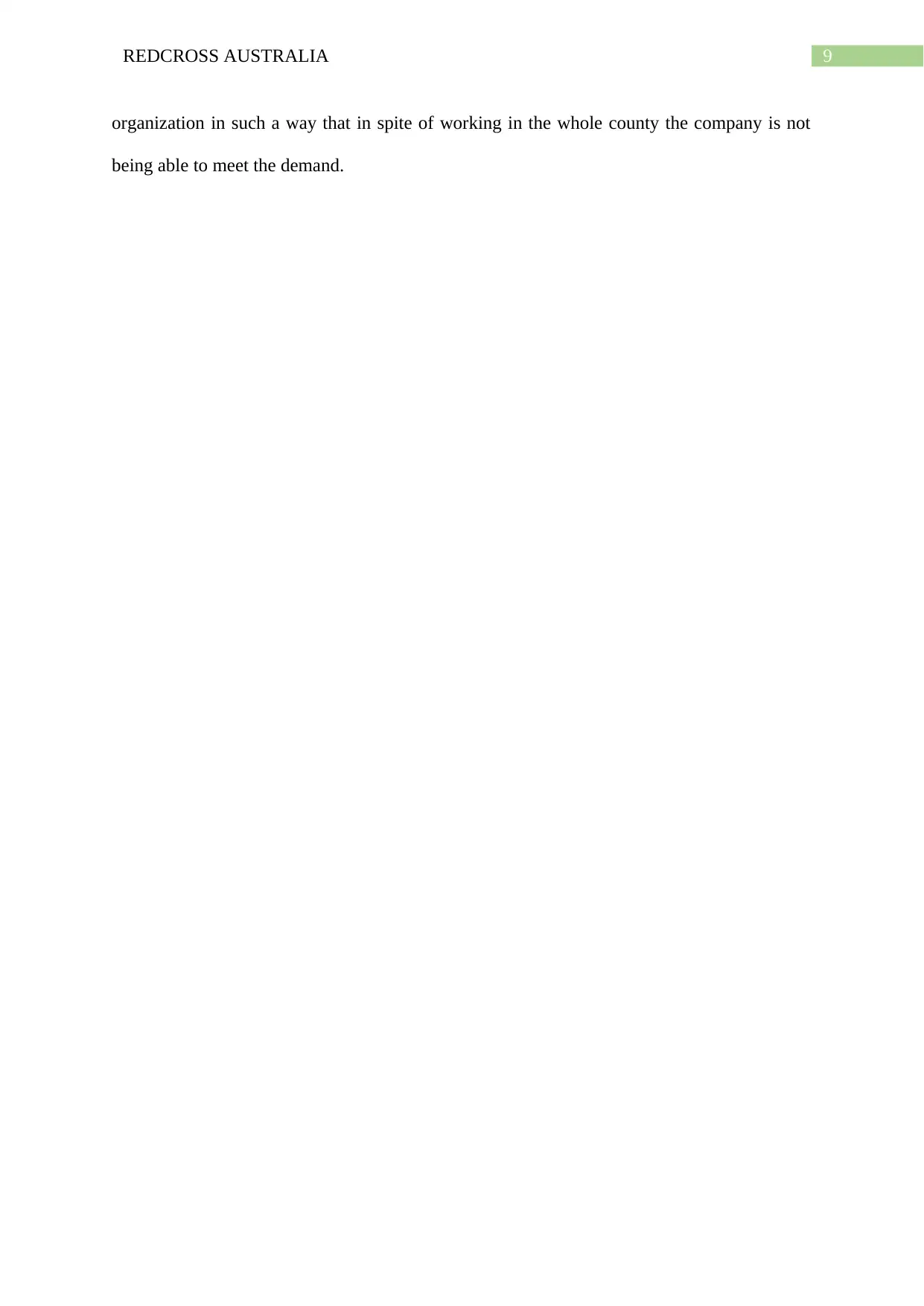
9REDCROSS AUSTRALIA
organization in such a way that in spite of working in the whole county the company is not
being able to meet the demand.
organization in such a way that in spite of working in the whole county the company is not
being able to meet the demand.
Paraphrase This Document
Need a fresh take? Get an instant paraphrase of this document with our AI Paraphraser
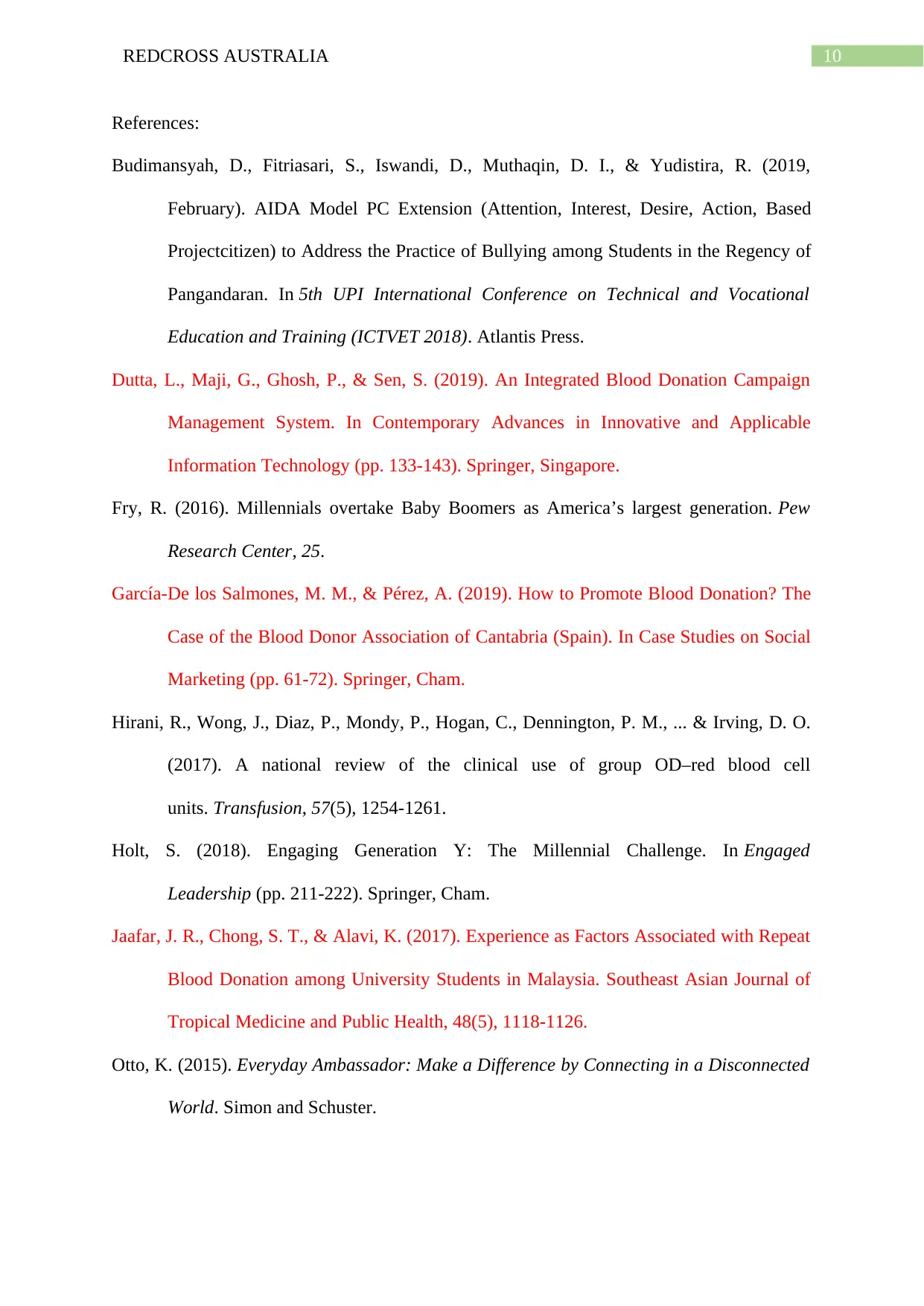
10REDCROSS AUSTRALIA
References:
Budimansyah, D., Fitriasari, S., Iswandi, D., Muthaqin, D. I., & Yudistira, R. (2019,
February). AIDA Model PC Extension (Attention, Interest, Desire, Action, Based
Projectcitizen) to Address the Practice of Bullying among Students in the Regency of
Pangandaran. In 5th UPI International Conference on Technical and Vocational
Education and Training (ICTVET 2018). Atlantis Press.
Dutta, L., Maji, G., Ghosh, P., & Sen, S. (2019). An Integrated Blood Donation Campaign
Management System. In Contemporary Advances in Innovative and Applicable
Information Technology (pp. 133-143). Springer, Singapore.
Fry, R. (2016). Millennials overtake Baby Boomers as America’s largest generation. Pew
Research Center, 25.
García-De los Salmones, M. M., & Pérez, A. (2019). How to Promote Blood Donation? The
Case of the Blood Donor Association of Cantabria (Spain). In Case Studies on Social
Marketing (pp. 61-72). Springer, Cham.
Hirani, R., Wong, J., Diaz, P., Mondy, P., Hogan, C., Dennington, P. M., ... & Irving, D. O.
(2017). A national review of the clinical use of group OD–red blood cell
units. Transfusion, 57(5), 1254-1261.
Holt, S. (2018). Engaging Generation Y: The Millennial Challenge. In Engaged
Leadership (pp. 211-222). Springer, Cham.
Jaafar, J. R., Chong, S. T., & Alavi, K. (2017). Experience as Factors Associated with Repeat
Blood Donation among University Students in Malaysia. Southeast Asian Journal of
Tropical Medicine and Public Health, 48(5), 1118-1126.
Otto, K. (2015). Everyday Ambassador: Make a Difference by Connecting in a Disconnected
World. Simon and Schuster.
References:
Budimansyah, D., Fitriasari, S., Iswandi, D., Muthaqin, D. I., & Yudistira, R. (2019,
February). AIDA Model PC Extension (Attention, Interest, Desire, Action, Based
Projectcitizen) to Address the Practice of Bullying among Students in the Regency of
Pangandaran. In 5th UPI International Conference on Technical and Vocational
Education and Training (ICTVET 2018). Atlantis Press.
Dutta, L., Maji, G., Ghosh, P., & Sen, S. (2019). An Integrated Blood Donation Campaign
Management System. In Contemporary Advances in Innovative and Applicable
Information Technology (pp. 133-143). Springer, Singapore.
Fry, R. (2016). Millennials overtake Baby Boomers as America’s largest generation. Pew
Research Center, 25.
García-De los Salmones, M. M., & Pérez, A. (2019). How to Promote Blood Donation? The
Case of the Blood Donor Association of Cantabria (Spain). In Case Studies on Social
Marketing (pp. 61-72). Springer, Cham.
Hirani, R., Wong, J., Diaz, P., Mondy, P., Hogan, C., Dennington, P. M., ... & Irving, D. O.
(2017). A national review of the clinical use of group OD–red blood cell
units. Transfusion, 57(5), 1254-1261.
Holt, S. (2018). Engaging Generation Y: The Millennial Challenge. In Engaged
Leadership (pp. 211-222). Springer, Cham.
Jaafar, J. R., Chong, S. T., & Alavi, K. (2017). Experience as Factors Associated with Repeat
Blood Donation among University Students in Malaysia. Southeast Asian Journal of
Tropical Medicine and Public Health, 48(5), 1118-1126.
Otto, K. (2015). Everyday Ambassador: Make a Difference by Connecting in a Disconnected
World. Simon and Schuster.
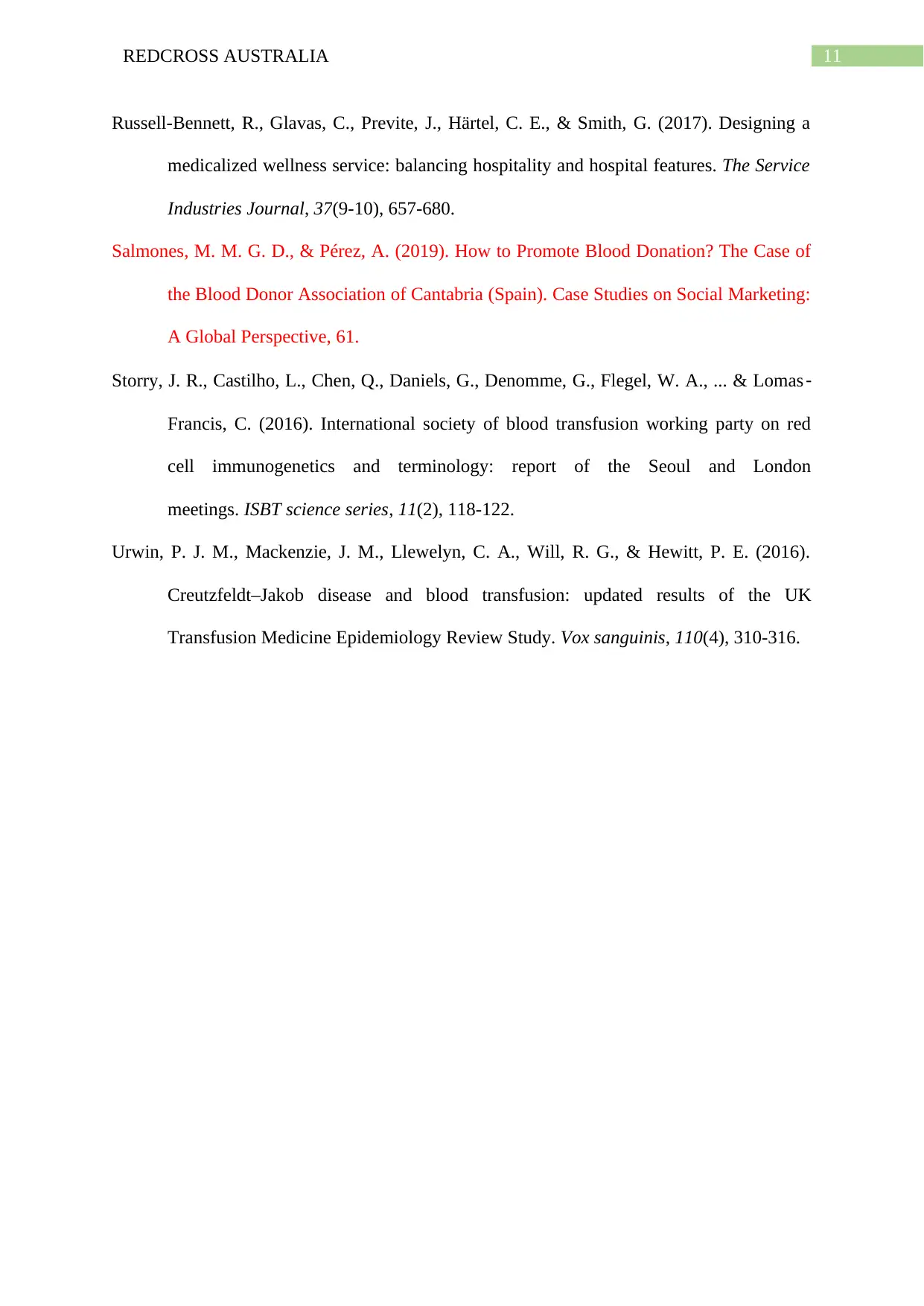
11REDCROSS AUSTRALIA
Russell-Bennett, R., Glavas, C., Previte, J., Härtel, C. E., & Smith, G. (2017). Designing a
medicalized wellness service: balancing hospitality and hospital features. The Service
Industries Journal, 37(9-10), 657-680.
Salmones, M. M. G. D., & Pérez, A. (2019). How to Promote Blood Donation? The Case of
the Blood Donor Association of Cantabria (Spain). Case Studies on Social Marketing:
A Global Perspective, 61.
Storry, J. R., Castilho, L., Chen, Q., Daniels, G., Denomme, G., Flegel, W. A., ... & Lomas ‐
Francis, C. (2016). International society of blood transfusion working party on red
cell immunogenetics and terminology: report of the Seoul and London
meetings. ISBT science series, 11(2), 118-122.
Urwin, P. J. M., Mackenzie, J. M., Llewelyn, C. A., Will, R. G., & Hewitt, P. E. (2016).
Creutzfeldt–Jakob disease and blood transfusion: updated results of the UK
Transfusion Medicine Epidemiology Review Study. Vox sanguinis, 110(4), 310-316.
Russell-Bennett, R., Glavas, C., Previte, J., Härtel, C. E., & Smith, G. (2017). Designing a
medicalized wellness service: balancing hospitality and hospital features. The Service
Industries Journal, 37(9-10), 657-680.
Salmones, M. M. G. D., & Pérez, A. (2019). How to Promote Blood Donation? The Case of
the Blood Donor Association of Cantabria (Spain). Case Studies on Social Marketing:
A Global Perspective, 61.
Storry, J. R., Castilho, L., Chen, Q., Daniels, G., Denomme, G., Flegel, W. A., ... & Lomas ‐
Francis, C. (2016). International society of blood transfusion working party on red
cell immunogenetics and terminology: report of the Seoul and London
meetings. ISBT science series, 11(2), 118-122.
Urwin, P. J. M., Mackenzie, J. M., Llewelyn, C. A., Will, R. G., & Hewitt, P. E. (2016).
Creutzfeldt–Jakob disease and blood transfusion: updated results of the UK
Transfusion Medicine Epidemiology Review Study. Vox sanguinis, 110(4), 310-316.
⊘ This is a preview!⊘
Do you want full access?
Subscribe today to unlock all pages.

Trusted by 1+ million students worldwide
1 out of 12
Related Documents
Your All-in-One AI-Powered Toolkit for Academic Success.
+13062052269
info@desklib.com
Available 24*7 on WhatsApp / Email
![[object Object]](/_next/static/media/star-bottom.7253800d.svg)
Unlock your academic potential
Copyright © 2020–2025 A2Z Services. All Rights Reserved. Developed and managed by ZUCOL.





